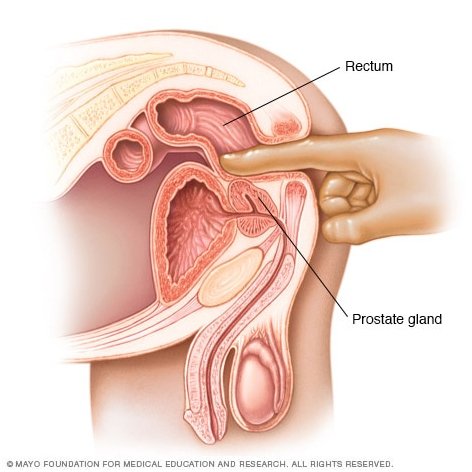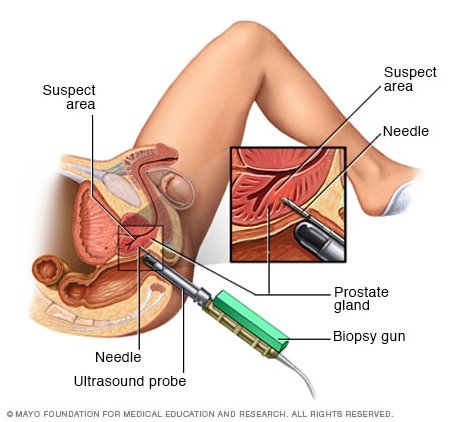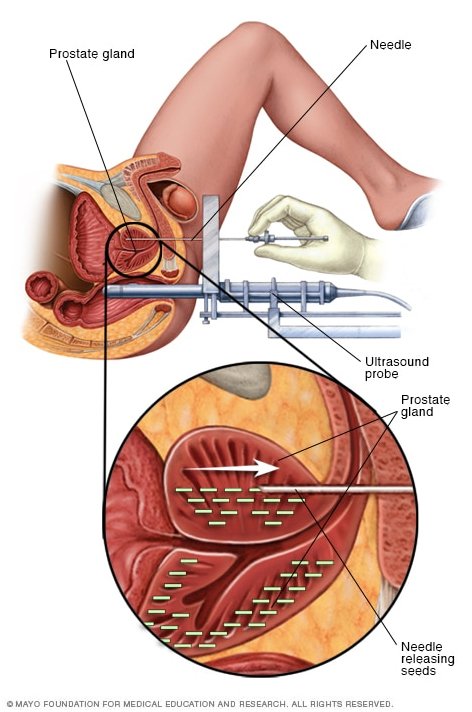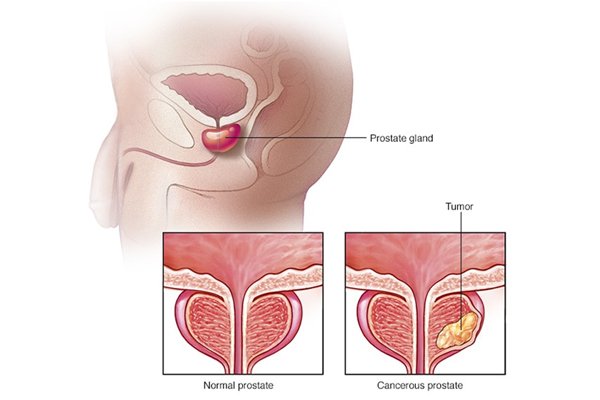Fig 1. Position of prostate gland and schematic representation of a normal prostate and cancerous prostate
The prostate is a small gland that sits below the bladder near the rectum. It surrounds the urethra, the passage in the penis through which urine and semen pass.The prostate gland is part of the male reproductive system. It produces most of the fluid that makes up semen that enriches sperm. The prostate needs the male hormone testosterone to grow and develop.The prostate is often described as being the size of a walnut and it is normal for it to grow as men age. Sometimes this can cause problems, such as difficulty urinating. These problems are common in older men and not always symptoms or signs of cancer.
Prostate cancer occurs when abnormal cells develop in the prostate. These abnormal cells can continue to multiply in an uncontrolled way and sometimes spread outside the prostate into nearby or distant parts of the body.Prostate cancer is one of the most common types of cancer in men. Usually prostate cancer grows slowly and is initially confined to the prostate gland, where it may not cause serious harm. However, while some types of prostate cancer grow slowly and may need minimal or even no treatment, other types are aggressive and can spread quickly.
Symptoms
Prostate cancer may cause no signs or symptoms in its early stages.Prostate cancer that is more advanced may cause signs and symptoms such as:
- Trouble urinating
- Decreased force in the stream of urine
- Blood in semen
- Discomfort in the pelvic area
- Bone pain
- Erectile dysfunction
Causes
It is not clear what causes prostate cancer. Prostate cancer begins when some cells in your prostate become abnormal. Mutations in the abnormal cells’ DNA cause the cells to grow and divide more rapidly than normal cells do. The abnormal cells continue living, when other cells would die. The accumulating abnormal cells form a tumor that can grow to invade nearby tissue. Some abnormal cells can also break off and spread (metastasize) to other parts of the body.
Risk factors
Factors that can increase your risk of prostate cancer include:
- Your risk of prostate cancer increases as you age.Prostate cancer is rare in men younger than 40, but the chance of having prostate cancer rises rapidly after age 50. About 6 in 10 cases of prostate cancer are found in men older than 65.
- For reasons not yet determined, black men carry a greater risk of prostate cancer than do men of other races. In black men, prostate cancer is also more likely to be aggressive or advanced.
- Family history.If men in your family have had prostate cancer, your risk may be increased. Also, if you have a family history of genes that increase the risk of breast cancer (BRCA1 or BRCA2) or a very strong family history of breast cancer, your risk of prostate cancer may be higher.
- Obese men diagnosed with prostate cancer may be more likely to have advanced disease that is more difficult to treat.
- Prostate cancer is most common in North America, northwestern Europe, Australia, and on Caribbean islands. It is less common in Asia, Africa, Central America, and South America.The reasons for this are not clear. More intensive screening in some developed countries probably accounts for at least part of this difference, but other factors such as lifestyle differences (diet, etc.) are likely to be important as well.
Prevention
You can reduce your risk of prostate cancer if you:
- Choose a healthy diet full of fruits and vegetables.Avoid high-fat foods and instead focus on choosing a variety of fruits, vegetables and whole grains. Fruits and vegetables contain many vitamins and nutrients that can contribute to your health.Whether you can prevent prostate cancer through diet has yet to be conclusively proved. But eating a healthy diet with a variety of fruits and vegetables can improve your overall health.
- Choose healthy foods over supplements.No studies have shown that supplements play a role in reducing your risk of prostate cancer. Instead, choose foods that are rich in vitamins and minerals so that you can maintain healthy levels of vitamins in your body.
- Exercise most days of the week.Exercise improves your overall health; helps you maintain your weight and improves your mood. Try to exercise most days of the week. If you’re new to exercise, start slow and work your way up to more exercise time each day.
- Maintain a healthy weight.If your current weight is healthy, work to maintain it by exercising most days of the week. If you need to lose weight, add more exercise and reduce the number of calories you eat each day. Ask your doctor for help creating a plan for healthy weight loss.
Screening for prostate cancer
Prostate cancer that is detected early, when it is still confined to the prostate gland has a better chance of successful treatment.Prostate screening tests might include:
- Digital rectal exam (DRE).During a DRE, your doctor inserts a gloved, lubricated finger into your rectum to examine your prostate, which is adjacent to the rectum. If your doctor finds any abnormalities in the texture, shape or size of the gland, you may need further tests.

Fig. 2Digital rectal exam
- Prostate-specific antigen (PSA) test.A blood sample is drawn from a vein in your arm and analyzed for PSA, a substance that’s naturally produced by your prostate gland. It is normal for a small amount of PSA to be in your bloodstream. However, if a higher than normal level is found, it may indicate prostate infection, inflammation, enlargement or cancer.PSA testing combined with DRE helps identify prostate cancers at their earliest stages.
If a DRE or PSA test detects an abnormality, your doctor may recommend further tests to determine whether you have prostate cancer, such as:
- If other tests raise concerns, your doctor may use transrectal ultrasound to further evaluate your prostate. A small probeis inserted into your rectum. The probe uses sound waves to create a picture of your prostate gland.
Collecting a sample of prostate tissue. If initial test results suggest prostate cancer, your doctor may recommend a procedure to collect a sample of cells from your prostate (prostate biopsy). Prostate biopsy is often done using a thin needle that’s inserted into the prostate to collect tissue. The tissue sample is analyzed in a lab to determine whether cancer cells are present.

Fig 3. Transrectal biopsy of the prostate gland
Determining whether prostate cancer is aggressive
When a biopsy confirms the presence of cancer, the next step is to determine the level of aggressiveness (grade) of the cancer cells. A laboratory pathologist examines a sample of your cancer to determine how much cancer cells differ from the healthy cells. A higher grade indicates a more aggressive cancer that is more likely to spread quickly.
In addition, genomic testing is increasingly being used to more accurately assess risk and detect aggressive prostate cancer.
Determining how far the cancer has spread
Once a prostate cancer diagnosis has been made, your doctor works to determine the extent (stage) of the cancer. If your doctor suspects your cancer may have spread beyond your prostate, one or more of the following imaging tests may be recommended:
- Bone scan
- Ultrasound
- Computerized tomography (CT) scan
- Magnetic resonance imaging (MRI)
- Positron emission tomography (PET) scan
Your doctor uses the information from these tests to assign your cancer a stage. Prostate cancer stages are indicated by Roman numerals ranging from I to IV. The lowest stages indicate the cancer is confined to the prostate. By stage IV, the cancer has grown beyond the prostate and may have spread to other areas of the body.
Treatment
Depending on the stage of the prostate cancer, your doctor may advise the following treatments:
- Active surveillance
- Surgery
- Radiation therapy
- Hormone therapy
- Chemotherapy
- Active surveillance
For men diagnosed with low-risk prostate cancer, treatment may not be necessary right away. Some men may never need treatment. Instead, doctors sometimes recommend active surveillance.
In active surveillance, regular follow-up blood tests, rectal exams and possibly biopsies may be performed to monitor progression of your cancer. If tests show your cancer is progressing, you may opt for a prostate cancer treatment such as surgery or radiation.
Active surveillance may be an option for cancer that isnot causing symptoms, is expected to grow very slowly and is confined to a small area of the prostate. Active surveillance may also be considered for someone who has another serious health condition or who is of an advanced age that makes cancer treatment more difficult.
Active surveillance carries a risk that the cancer may grow and spread between checkups, making the cancer less likely to be cured.
- Surgery to remove the prostate
Surgery for prostate cancer involves removing the prostate gland (radical prostatectomy), some surrounding tissue and a few lymph nodes. Radical prostatectomy can be performed in several ways:
- Using a robot to assist with surgery.During robot-assisted surgery, the instruments are attached to a mechanical device (robot) and inserted into your abdomen through several small incisions. The surgeon sits at a console and uses hand controls to guide the robot to move the instruments. Robotic prostatectomy may allow the surgeon to make more-precise movements with surgical tools than is possible with traditional minimally invasive surgery.
- Making an incision in your abdomen.During retropubic surgery, the prostate gland is taken out through an incision in your lower abdomen.
Radical prostatectomy carries a risk of urinary incontinence and erectile dysfunction.
- Radiation therapy
Radiation therapy uses high-powered energy to kill cancer cells. Prostate cancer radiation therapy can be delivered in two ways:
- Radiation that comes from outside of your body (external beam radiation).During external beam radiation therapy, you lie on a table while a machine moves around your body, directing high-powered energy beams, such as X-rays or protons, to your prostate cancer. You typically undergo external beam radiation treatments five days a week for several weeks.
- Radiation placed inside your body (brachytherapy).Brachytherapy involves placing many rice-sized radioactive seeds in your prostate tissue. The radioactive seeds deliver a low dose of radiation over a long period of time. Your doctor implants the radioactive seeds in your prostate using a needle guided by ultrasound images. The implanted seeds eventually stop emitting radiation and don’t need to be removed.

Fig 4. Permanent prostate brachytherapy
Side effects of radiation therapy can include painful, frequent or urgent urination, as well as rectal symptoms such as loose stools or pain when passing stools. Erectile dysfunction can also occur.
- Hormone therapy
Hormone therapy is treatment to stop your body from producing the male hormone testosterone. Prostate cancer cells rely on testosterone to help them grow. Cutting off the supply of testosterone may cause cancer cells to die or to grow more slowly.Removing your testicles reduces testosterone levels in your body.Hormone therapy is used in men with advanced prostate cancer to shrink the cancer and slow the growth of tumors. In men with early-stage prostate cancer, hormone therapy may be used to shrink tumors before radiation therapy, which can increase the likelihood that radiation therapy will be successful.
Side effects of hormone therapy may include erectile dysfunction, hot flashes, loss of bone mass, reduced sex drive and weight gain.
- Chemotherapy
Chemotherapy uses drugs to kill rapidly growing cells, including cancer cells. Chemotherapy can be administered through a vein in your arm, in pill form or both.Chemotherapy may be a treatment option for men with prostate cancer that has spread to remote body locations. Chemotherapy may also be an option for cancers that donot respond to hormone therapy.
Complications
Complications of prostate cancer and its treatments include:
- Cancer that spreads (metastasizes).Prostate cancer can spread to nearby organs, such as your bladder, or travel through your bloodstream or lymphatic system to your bones or other organs. Prostate cancer that spreads to the bones can cause pain and broken bones. Once prostate cancer has spread to other areas of the body, it may still respond to treatment and may be controlled, but it is unlikely to be cured.
- Both prostate cancer and its treatment can cause urinary incontinence. Treatment for incontinence depends on the type you have, how severe it is and the likelihood it will improve over time. Treatment options may include medications, catheters and surgery.
- Erectile dysfunction.Erectile dysfunction can result from prostate cancer or its treatment, including surgery, radiation or hormone treatments. Medications, vacuum devices that assist in achieving erection and surgery are available to treat erectile dysfunction.

